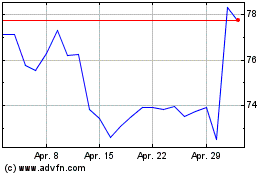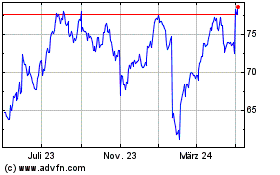By David Benoit, Jacob Bunge and Chelsey Dulaney
Dow Chemical Co. and DuPont Co. announced Friday that they have
agreed to merge, fusing two of the U.S.'s oldest companies into a
chemical giant currently worth about $130 billion.
The deal would reshape the chemical and agricultural industries
and comes as sinking commodity prices and a strengthening U.S.
dollar have pressured revenue at both Dow and DuPont. The
combination was pitched as a way to help the companies find
synergies before breaking up into three separate businesses later
down the road.
Dow's shares rose 0.7% in premarket trading, while DuPont shares
slipped 2.9% as the company also announced restructuring plans and
gave downbeat comments on its 2016 sales growth.
Under the deal's terms, shareholders of Dow Chemical will get 1
share in the new company called DowDuPont for each Dow share, while
DuPont shareholders will get 1.282 shares for each DuPont share.
The deal's structure will give Dow and DuPont shareholders equal
stakes in the combined company, excluding the impact of preferred
shares.
Dow's Chief Executive Andrew Liveris will be executive chairman
of the new company, with DuPont Chief Executive Edward Breen
keeping the CEO title. DowDuPont will have dual headquarters in
Midland, Mich., and Wilmington, Del.
The deal "was always in front of us to get done, in the right
way," Mr. Liveris said in an interview. "We believe this is the
right way." The Wall Street Journal reported the companies were in
talks to merge on Tuesday.
Mr. Breen said DuPont's board, which he joined early last year,
also had looked at the possibility of combining with its longtime
rival in chemicals. He said Mr. Liveris called him on Mr. Breen's
first day running DuPont in October, and pursuing a merger became
easier because the companies were almost exactly the same size by
market value.
"That always makes for quicker, easier negotiation," Mr. Breen
said. Structuring the deal as a merger of equals will also help
minimize taxes paid on the transaction, he said.
The companies expect the merger, which must be approved by
regulators and both companies' shareholders, to be completed by the
second half of 2016.
The deal would be followed by a three-way breakup of the
combined company, a common approach to mergers and acquisitions of
late. The three resulting companies, which would be publicly
traded, would be focused on agriculture, material sciences and
specialty products.
The companies said the breakup would occur "as soon as feasible"
but that it still could take up to two years after the merger
announced Friday closes, suggesting the breakup may not occur until
2018.
Mr. Liveris and Mr. Breen said they haven't yet determined what
their roles would be when the combined DowDuPont splits into three
separate companies.
There is no guarantee antitrust regulators would bless the union
or that a breakup plan would address any such concerns. The merger
would combine two top suppliers of industrial and agricultural
chemicals and crop seeds, but it comes as sinking commodity prices
and a strengthening U.S. dollar have hurt revenue across the
companies' business lines.
Mr. Breen said no major divestitures were expected as the deal
goes before antitrust reviewers. Dow and DuPont both will likely
sell minor pieces of their businesses, "but nothing that would move
the needle," Mr. Breen said.
Mr. Breen said that merging with Dow and then breaking the
combined entity into three units is far preferable to a split of
DuPont itself, a path proposed in late 2014 by activist investment
firm Trian Fund Management LP. The planned deal is "a totally
different scenario," Mr. Breen said. "We've created three leading,
strategic platforms, instead of splitting DuPont into three small
pieces," he said.
Should the deal come to fruition, a combination of the
companies, each more than a century old, would be one of the
biggest in a year marked by big deals. So far, companies have
struck some $4.35 trillion of takeovers in 2015, eclipsing 2007 as
the top year on record for deals, according to Dealogic.
Both Dow and DuPont have been restructuring their businesses as
they've come under pressure from shareholders to slim themselves
and focus on faster-growing business lines--sometimes by shedding
products that made them famous.
DuPont has exited performance paints and coatings, including the
business that invented Teflon nonstick pan coating. Dow, meanwhile,
has gotten out of selling materials like chlorine and the epoxy
used in everything from space travel to Ziploc bags.
The companies expect a combination would accelerate cost-cutting
and see the deal resulting in $3 billion in cost synergies, to be
fully realized within two years of the deal's closing.
Ahead of the merger, Dow and DuPont said they would further
reshape their businesses.
DuPont said separately Friday that it would cut $700 million in
costs in 2016, affecting 10% of its global workforce. DuPont had
about 63,000 employees at the end of 2014, according to a
regulatory filing. The company expects to book a pretax charge of
$780 million related to the cuts.
DuPont said it expects sales growth next year to be
"challenging" because of agricultural headwinds and the
strengthening of the U.S. dollar against the Brazilian Real. DuPont
will give guidance for 2016 on Jan. 27.
For its part, Dow said that it would take full ownership of Dow
Corning Corp., which it jointly owns with Corning Inc. Dow said it
expects the move to yield more than $1 billion in annual earnings
before interest, taxes, depreciation and amortization. That
transaction is slated to close by the first half of 2016.
The DowDuPont deal comes shortly after DuPont named Mr. Breen, a
turnaround expert, as the company's chief executive after a stint
as interim CEO. Prior CEO Ellen Kullman retired after fending off
Nelson Peltz and Trian Fund Management LP, which sought board seats
and criticized the company--and its leadership--for bloated
corporate spending and a continued failure to hit earnings
forecasts.
Soon after Mr. Breen stepped in to run DuPont in October, Mr.
Liveris called him to propose a deal. For more than a decade, Mr.
Liveris had sought to merge with DuPont, and he pitched a deal as a
way to find synergies before breaking up the businesses into more
focused operations, the people said.
For its part, Dow also has had an activist investor. Last year,
the company added two directors nominated by Daniel Loeb's Third
Point LLC after Mr. Loeb sought a breakup of the company and
threatened a proxy fight.
Talks of consolidation in the agricultural-sciences industry
have heated up recently, with companies scrambling to adjust to
pressure on lower prices for their commodities.
Last month, The Wall Street Journal reported that DuPont was
discussing a potential combination of its agriculture division with
seed giant Syngenta AG, and separately exploring a potential
agriculture deal with Dow. Monsanto Co. earlier this year abandoned
a $46 billion bid for Syngenta amid resistance from the Swiss
company.
Dana Cimilluca and Dana Mattioli contributed to this
article.
Write to David Benoit at david.benoit@wsj.com, Jacob Bunge at
jacob.bunge@wsj.com and Chelsey Dulaney at
Chelsey.Dulaney@wsj.com
(END) Dow Jones Newswires
December 11, 2015 08:13 ET (13:13 GMT)
Copyright (c) 2015 Dow Jones & Company, Inc.
DuPont de Nemours (NYSE:DD)
Historical Stock Chart
Von Jun 2024 bis Jul 2024

DuPont de Nemours (NYSE:DD)
Historical Stock Chart
Von Jul 2023 bis Jul 2024
